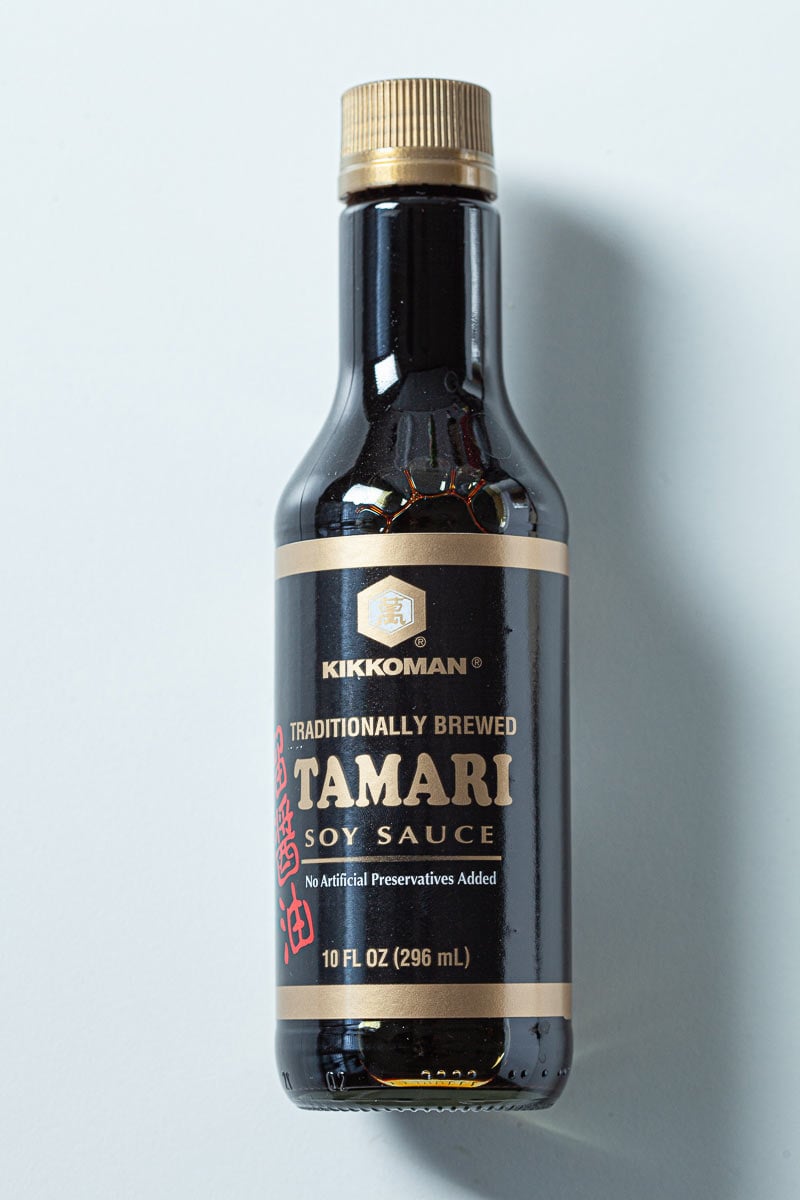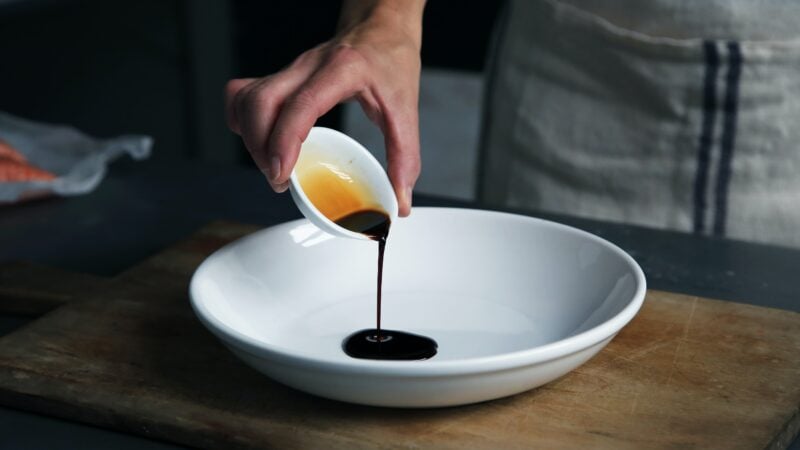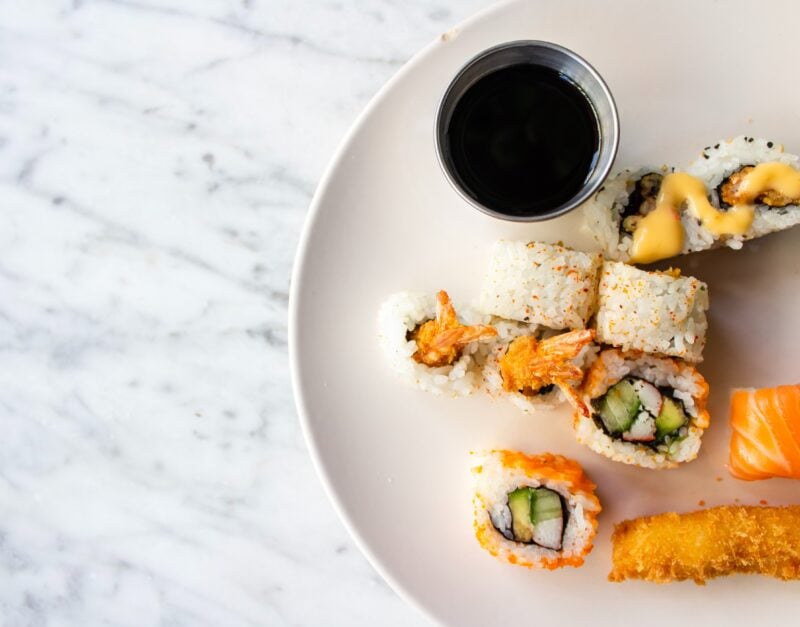
WHAT IS TAMARI SAUCE?
Tamari sauce is a type of soy sauce from Japan that is formed from miso, which is another word for fermented soybean paste. As miso ferments, a liquid forms around it, which is actually Tamari sauce. If you’re familiar with miso, you know that it boasts a strong umami flavor, which is why tamari sauce is often considered more robust than traditionally made soy sauces.
Tamari sauce is gluten-free
Because tamari sauce is made without wheat, consistently only of water, soybeans, and salt, folks with a gluten allergy or sensitivity can enjoy it.
In fact, authentic tamari sauce ingredients are simple and few. It’s made with just three pure ingredients: soybeans, water, and salt.
Read the labels closely to ensure the brand you purchase is certified “gluten free” and has not come into contact with other products containing wheat.

TAMARI SAUCE TASTE
Like regular soy sauce, tamari sauce boasts a strong umami taste. It’s earthy, savory, and full of flavor. Tamari sauce typically contains significantly less sodium than other types of soy sauces. To further cut down on salt, try reduced sodium tamari.
As far as texture and consistency go, tamari sauce is slightly thicker than soy sauce. The rich texture actually makes it perfect for dips and marinades.
TAMARI Sauce VS. SOY SAUCE
Because both tamari sauce and soy sauce are made with fermented soybeans and boast a similar flavor, they’re comparable, with a few unique differences. The biggest differences are the salt level, consistency, and ingredients.
Tamari sauce is slightly thicker than soy sauce. It is also made with less salt, making it a better choice for those who are trying to reduce sodium in their diet.
If you are substituting tamari in a recipe that calls for soy sauce, consider adding a pinch of salt to make up for this difference. On the other hand, you’ll want to omit any additional salt if you’ll be using soy sauce in place of tamari.
Another difference of note is the consistency. This will only be noticeable in recipes for dipping sauces and the like. Be aware that if you use tamari your sauce will be on the thicker side, and vice versa for soy sauce.
Tamari is made with just soybeans, water, and salt. Soy sauce is made with soybeans, wheat, salt, and a fermenting agent. The omission of wheat is the reason many with gluten allergies choose to substitute tamari sauce for soy sauce.
TAMARI SAUCE SUBSTITUTE IDEAS
The most obvious choice for a tamari sauce substitute is, of course, soy sauce. But, if you want to try something new (or if you have a soybean allergy) here are some tamari sauce substitute ideas to inspire you:
TAMARI SAUCE RECIPE IDEAS
All of this talk of sauces may have you wondering about tamari sauce recipe ideas! It’s a fairly common ingredient in Asian-inspired cooking, and it can add a really unique flavor to other dishes. Below are some tamari recipes to try:
Recipes using Tamari Sauce
THE BEST TAMARI SAUCES
There are several brands that make tamari sauce. Each person will have their own preferences, but we’ve come up with this list to help you find the perfect brand for you:

TAMARI SAUCE COMMONLY ASKED QUESTIONS
Is Tamari the same as Soy Sauce?
Tamari sauce is made from soybeans, but it is not the same as traditional soy sauce. Essentially, tamari sauce differs from traditional soy sauce in several ways. Traditional soy sauce is made with wheat, so it is not safe to consume for people with a gluten allergy. Tamari, on the other hand, is naturally gluten-free. It is also a bit richer in texture and contains less sodium.
What Does Tamari Sauce Taste Like?
Tamari sauce has a rich, earthy, umami taste. It’s not as salty as soy sauce, meaning it’s a bit less intense in flavor. Because it isn’t overloaded with salt, you can really taste the complex flavor profile of the fermented soybeans. It’s a unique way to add a bit of earthy flavor to many different types of dishes.
What Do You Use Tamari Sauce For?
Tamari is a commonly used ingredient in a variety of recipes. It’s most often seen in stir-fries, sauces, soups, and marinades. It’s also not just for Asian-inspired dishes! Use it in a variety of sauces no matter the cuisine, or include it with several other dipping sauces for more variety.
Is Tamari Better Than Soy Sauce?
There is a time and place for both tamari sauce and soy sauce, depending on the recipe. It should be noted that tamari is higher in protein, is gluten-free, contains natural antioxidants, is less salty, and is rich in flavor. We regularly use both sauces in our recipes and recommend you try both, to discover your favorite flavor profile.
Try this recipe using tamari sauce:

Tender Beef and Broccoli in 30 Minutes
s Beef and Broccoli Stir Fry is tender, flavorful, and healthy. This family favorite is perfect for busy weeknights.
- Prep Time: 20 min
- Cook Time: 10 min
- Total Time: 30 minutes
For the Sauce:
- 1/2 cup regular strength beef broth
- 3 TB Tamari soy sauce
- 3 TB Japanese rice wine, mirin
- 3 TB Asian seasoned rice vinegar
- 3 TB oyster sauce
- 2 tsp cornstarch
- 1 tsp ground ginger
For the Stir Fry:
- 5 TB olive oil, divided
- 6 cloves fresh garlic, chopped
- 1 small onion, chopped
- 3 cups fresh broccoli florets
- 1 – 1.5 lb sirloin steak, sliced across the grain into very thin, bite-sized pieces
- Optional: 1/4-1/2 tsp crushed red pepper flakes
- Make the Sauce: In a bowl, combine all Sauce ingredients. Use hand whisk to be sure cornstarch is fully dissolved into the sauce mixture (any bit of undissolved cornstarch will cause gummy lumps in dish.) Set sauce aside.
- Aromatics: In a large, deep pan, add 3 TB olive oil over medium-high heat until oil is hot. Add garlic and onion, stirring 2 minutes until fragrant and translucent.
- Cook: Add broccoli florets, cooking about 2 minutes or just until just tender. (Note: If you prefer a bit of char, let florets brown and flip only occasionally, without stirring too much.) Transfer vegetable mixture into a dish and set aside.
- Beef: Add 2 TB olive oil into the now-empty pan, over medium high heat. Meanwhile, pat-dry all pieces of sliced sirloin steak to remove any excess moisture. Once oil is hot, add beef in a single layer in to the pan. Let beef brown, uninterrupted, for 3 minutes for bottom to brown. Once bottom of beef slices are browned, give it a good stir.
- Combine: Add back the cooked broccoli/garlic mixture and the sauce you prepared. Stir to incorporate well and continue to cook for another minute. Taste and add red pepper flakes, if desired. Remove from heat and serve with fluffy rice or noodles.
Notes
If you enjoyed this recipe, please come back and give it a rating ♡
Nutrition
- Serving Size: 1
- Calories: 364
- Sugar: 2.2 g
- Sodium: 925 mg
- Fat: 28.4 g
- Carbohydrates: 8.2 g
- Fiber: 1.8 g
- Protein: 19.7 g
- Cholesterol: 52.4 mg





More Stories
Miami’s Best Cook Books
5 Beginner Tips For Camping Without Electricity
Instant Read Cooking Thermometer – A Simple Way to Prevent Food Poisoning